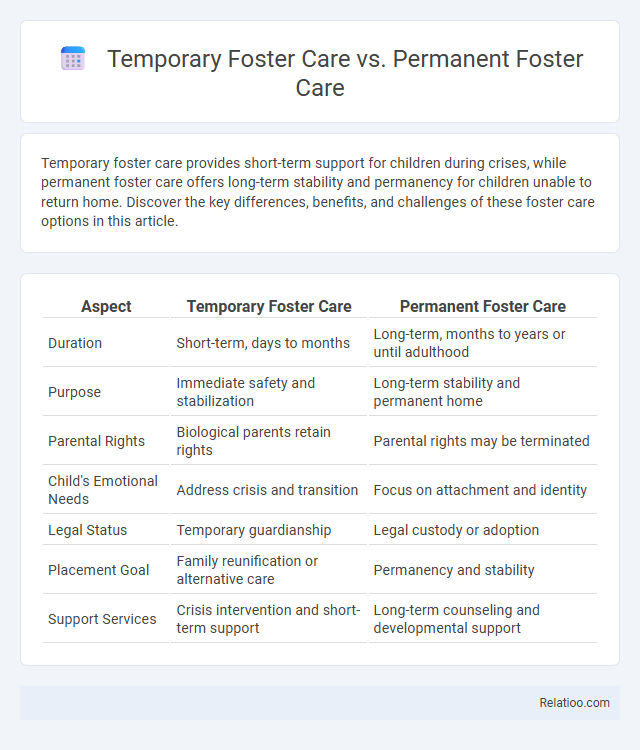Temporary foster care provides short-term support for children during crises, while permanent foster care offers long-term stability and permanency for children unable to return home. Discover the key differences, benefits, and challenges of these foster care options in this article.
Table of Comparison
| Aspect | Temporary Foster Care | Permanent Foster Care |
|---|---|---|
| Duration | Short-term, days to months | Long-term, months to years or until adulthood |
| Purpose | Immediate safety and stabilization | Long-term stability and permanent home |
| Parental Rights | Biological parents retain rights | Parental rights may be terminated |
| Child's Emotional Needs | Address crisis and transition | Focus on attachment and identity |
| Legal Status | Temporary guardianship | Legal custody or adoption |
| Placement Goal | Family reunification or alternative care | Permanency and stability |
| Support Services | Crisis intervention and short-term support | Long-term counseling and developmental support |
Introduction to Foster Care: Temporary vs Permanent
Temporary foster care provides short-term placement for children in need of immediate safety and stability, often during family crises or emergencies. Permanent foster care involves long-term commitment, offering children a stable, nurturing environment until they can achieve adoption, reunification, or independent living. Foster parenting encompasses both temporary and permanent care, requiring caregivers to support children's emotional, social, and developmental needs within the foster system.
Definitions: What is Temporary Foster Care?
Temporary foster care provides short-term placement for children who need immediate safety and support due to family crises or emergencies, offering a stable environment until reunification or long-term solutions are found. Permanent foster care involves long-lasting arrangements where children remain with foster families when returning to their birth families is not possible, creating a lifelong sense of security and belonging. Your understanding of these definitions helps clarify foster parenting roles, which encompass both temporary and permanent care responsibilities to nurture and protect children in transition.
Defining Permanent Foster Care
Permanent foster care provides children with a long-term, stable home when reunification with birth parents is not possible, distinguishing it from temporary foster care, which is designed for short-term placements during family crises. Unlike temporary foster care, permanent foster care emphasizes permanency planning, ensuring children's emotional and developmental needs are met through a lasting caregiver relationship. Foster parenting encompasses both temporary and permanent roles, requiring caregivers to support children while either facilitating family reunification or creating a lifelong family connection in permanent care.
Key Differences Between Temporary and Permanent Foster Care
Temporary foster care provides short-term accommodation for children during family crises, focusing on safety and urgent needs, while permanent foster care aims to offer long-term stability and emotional support until adoption or majority. Foster parenting involves caregiving responsibilities encompassing both temporary and permanent placements, requiring adaptability to the child's evolving needs. Understanding the distinctions between temporary and permanent foster care helps you make informed decisions about the type of foster care best suited for your commitment and the child's welfare.
Eligibility Criteria for Each Foster Care Type
Temporary foster care eligibility typically requires caregivers to provide short-term support for children in crisis, often mandating a stable home environment, background checks, and basic training. Permanent foster care eligibility demands a higher level of commitment, including long-term residency provisions, foster parent licensing, and sometimes specialized training for managing complex emotional or behavioral needs. Foster parenting eligibility encompasses both temporary and permanent care criteria, emphasizing suitability assessments, legal clearances, and ongoing education to ensure the best child welfare outcomes.
Placement Process: Temporary vs Permanent Foster Care
Temporary foster care placements involve short-term caregiving while authorities work to reunite the child with their family or find a permanent solution, emphasizing urgent and flexible arrangements. Permanent foster care requires a thorough, often lengthier placement process focused on stability, legal permanency, and long-term family integration. Your role in temporary foster care may involve quicker adjustment periods, whereas permanent placements demand deeper commitment and comprehensive background assessments.
Roles and Responsibilities of Foster Parents
Temporary foster care requires foster parents to provide short-term stability and support to children during emergencies or transitional periods, emphasizing adaptability and crisis management skills. Permanent foster care involves a long-term commitment where foster parents take on comprehensive roles, including meeting educational, emotional, and medical needs, fostering a nurturing environment akin to a permanent family structure. Foster parenting overall demands critical responsibilities such as collaborating with social workers, advocating for the child's best interests, maintaining consistent routines, and supporting the child's development through empathy and patience.
Impact on Children: Stability and Emotional Wellbeing
Temporary foster care provides children with immediate safety and shelter but may lead to emotional uncertainty due to frequent transitions. Permanent foster care aims to offer long-term stability, significantly enhancing a child's emotional wellbeing by fostering secure attachments and consistent support. Foster parenting involves the ongoing commitment to nurturing children's development, directly impacting their stability and emotional health through sustained care and positive relationships.
Legal Considerations and Parental Rights
Temporary foster care involves a legal arrangement where the child's parental rights remain intact, giving biological parents the possibility of reunification. Permanent foster care often requires a termination of parental rights or long-term guardianship, legally transferring most parental responsibilities to foster parents. Understanding these distinctions is crucial for your role as a foster parent, as legal obligations and rights differ significantly between temporary placement, permanent care, and traditional foster parenting.
Choosing the Right Foster Care Option
Choosing the right foster care option depends on the child's needs and the family's capacity. Temporary foster care provides short-term refuge for children during emergencies or transitional periods, while permanent foster care offers a long-term stable environment when reunification with birth parents is not possible. Foster parenting requires commitment, training, and emotional resilience to support children's healing and development in either setting.

Infographic: Temporary Foster Care vs Permanent Foster Care
 relatioo.com
relatioo.com